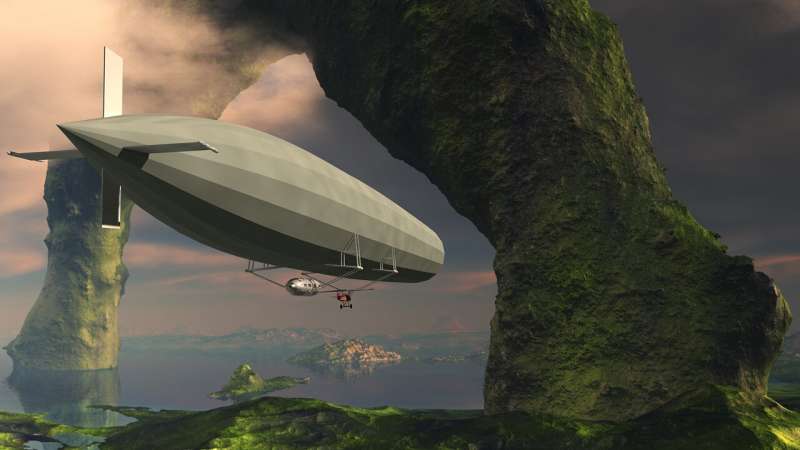This article has been reviewed according to Science X's editorial process and policies. Editors have highlighted the following attributes while ensuring the content's credibility:
fact-checked
reputable news agency
proofread
How Silicon Valley will put airships back in flight

It's longer than three Boeing 737s. Someday it could carry up to five tons of cargo and float from San Francisco to Chicago.
Long hidden in a dark hangar at Moffett Federal Airfield in Santa Clara, California, the remarkable Pathfinder 1—a gigantic white cigar-shaped airship—was rolled out into the bright Bay Area sunshine for some quick exercise last week, then rolled back in.
The behemoth aircraft, the brainchild of Google co-founder Sergey Brin and aviation innovator Alan Weston, behaved exactly as intended.
It didn't float, because it was securely tethered by ropes held by ground crew. That's planned for next time, probably within several weeks. Its initial maneuvers will be around Moffett Field, which Google leases from NASA Ames. Over the next year, it will fly several FAA-approved missions at an altitude below 1500 feet over the waters of the South Bay, including the Dumbarton Bridge.
But, as hoped, Pathfinder "superheated" when its skin was warmed by the sun, causing it to expand and lighten. When propelled by small electric motors, it swung one direction, then another.
"It performed really well," said Weston, chief executive officer of maker LTA Research and former director of programs at NASA's Ames Research Center, where he led more than 50 spacecraft, rocket, interceptor and air vehicle missions that revolutionized space science.
The Pathfinder is not a blimp, like the familiar balloons that drift over football stadiums. Blimps have no internal structure so can lose their shape, and deflate. The Pathfinder is an dirigible, with a rigid framework of 10,000 carbon-fiber reinforced tubes and 3,000 titanium hubs to form a protective skeleton around the gas cells, surrounded by a lightweight synthetic Tedlar skin.
The airship is about 400 feet long. By comparison, the traditional Goodyear blimp is 250 feet long.
Pathfinder 1 will be the largest aircraft to take to the skies since the ill-fated Hindenburg dirigible of the 1930s, a major air disaster that was broadcast to people all over the world.
A towering example of technological prowess, the Hindenburg was nearing the end of a three-day voyage across the Atlantic Ocean from Germany when flames erupted from its skin. In one horrifying minute, 36 people died.
But unlike the Hindenburg, Pathfinder is not filled with flammable hydrogen. Instead it is filled with stable helium, which is much safer—and creates lift without burning fuel. The helium is held in 13 giant rip-stop nylon cells and monitored by lidar laser systems.
The goal of this week's Pathfinder outing was to study how the vehicle's internal helium and polymer skin responded to sunshine, and whether its propeller motors, four on each side, could redirect its weathervane-like tendencies.
"Everybody's super happy with the data we gathered" from the airship's first outing in daylight, Weston said. "We gained an understanding of 'how does it work?' "
Until now, Pathfinder has undergone only in-hangar testing. Three months ago, it was wheeled out in darkness to see how it handled the world outside, without the influence of the hot sun.
For most of aviation history, lighter-than-air vehicles (or LTAs) have never been particularly popular, because they're big and comparatively slow
But technological advancements such as improved motors, solar cells, fly-by-wire controls and lidar sensing could help make such air travel feasible—and someday, perhaps, commercially viable.
LTA, which stands for "Lighter Than Air," was founded in 2016 but has operated largely under the radar. It now has 250 employees.
The company devised a rotisserie system, called "the roller coaster," where the entire airship sits in a cradle and rolls, so fabrication and assembly teams can work at ground level.
"Initially, it was just a crazy idea. Now it's not a crazy idea—it's a revolutionary idea," boosting accuracy and speeding up the manufacturing process by ten-fold, said Weston, "It's faster, better, cheaper, safer."
Pathfinder's outing has offered a vision of what aviation could look like years from now—one in which aircraft don't emit dangerous greenhouse gases.
It could move people and things that don't need to travel very quickly, such as delivering humanitarian aid to remote disaster sites. Traditional aircraft often can't land in damaged landscapes.
"I believe that airships can perform a complementary function," in addition to other efforts, "to provide humanitarian aid and disaster relief," said Weston.
Brin, worth an estimated $105 billion according to the Bloomberg Billionaires Index, also funds a disaster charity called Global Support and Development, which deploys boats to provide aid after volcanic eruptions, earthquakes and storms.
LTA is one of many companies working on electric aviation. A French company called Flying Whales is building an airship, also lifted by helium, that could carry up to 60 tons of cargo. Hybrid Air Vehicles, a British company, has developed a helium-based "Airlander 10" aircraft to transport people in rural regions. The New Mexico startup Sceye is making a helium-powered aircraft that could hover high in the stratosphere, perhaps offering a new tool for telecommunications.
Pathfinder 1 is just the first in what could be a family of airships, according to Weston.
Even as this prototype learns how to reliably fly in real-world conditions, LTA is starting construction of another and much larger airship, called Pathfinder 3, in the same Akron, Ohio, hangar where Goodyear built the U.S. Navy's rigid airships of the 1930s.
That aircraft, one-third bigger than Pathfinder 1, could be ready for flight later this year.
2023 MediaNews Group, Inc.
Distributed by Tribune Content Agency, LLC.















